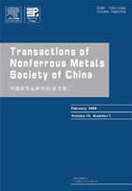Effect of Ag micro-alloying on elevated-temperature creep resistance of Mg-Gd-Y-Zr extrusion bars
(1. School of Materials Science and Engineering, Central South University, Changsha 410083, China;
2. Hunan Meiyu Technology Co. Ltd., Yueyang 414000, China;
3. Research Institute of Light Alloy, Central South University, Changsha 410083, China)
2. Hunan Meiyu Technology Co. Ltd., Yueyang 414000, China;
3. Research Institute of Light Alloy, Central South University, Changsha 410083, China)
Abstract: The effects of trace Ag on the tensile strength and creep resistance of Mg-7.5Gd-1.5Y- 0.4Zr (wt.%) extrusion bars were investigated at temperatures of 175-275 °C, via tensile tests and creep tests, electron back-scatter diffraction, and transmission electron microscopy. Adding trace Ag improves the tensile strength and creep resistance of Mg-Gd-Y-Zr alloys at elevated temperatures. During the creep process, precipitate-free zones (PFZs) are formed near grain boundaries and perpendicular to the loading direction, while chain-like β′-Mg7RE precipitates are distributed in a special direction ( ) in grain interior. After adding Ag element, the creep resistance of the Mg-Gd-Y-Zr-Ag is improved due to the suppression of dislocation movement by the synergistic effect of narrower PFZs, finer β′-Mg7RE precipitates in the grain interior and more stable β-Mg5RE phase located on the grain boundaries.
Key words: trace Ag; creep resistance; precipitate-free zones; extrusion; Mg-Gd-Y-Zr alloy

